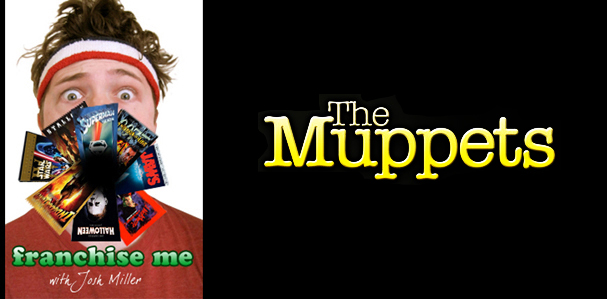
Hollywood loves a good franchise. The movie-going public does too. Horror, action, comedy, sci-fi, western, no genre is safe. And any film, no matter how seemingly stand-alone, conclusive, or inappropriate to sequel, could generate an expansive franchise. They are legion. We are surrounded. But a champion has risen from the rabble to defend us. Me. I have donned my sweats and taken up cinema’s gauntlet. Don’t try this at home. I am a professional.
Let’s be buddies on the Facebookz!
The Franchise: The Muppets — following the schtick-heavy misadventures of an eclectic race of puppet-like beings who thrive and survive amongst us in the regular human world. Birthed in the mid-1950’s by puppeteering super-champ Jim Henson for use in advertising commercials, the Muppet aesthetic/brand has since infiltrated every conceivable niche, medium and outlet imaginable, including television, music albums, motion pictures, video games, comic books, view finder stories, and literature. Since I imagine some may be disappointed to learn that I won’t be covering The Muppet Show, I figure an explanation is due… The reason is twofold: 1) While The Muppet Show is obviously where Henson’s Muppet creations solidified into the form we think of when we hear “the Muppets,” it was really just the culmination point of Henson’s success story; several of the central Muppets, like Kermit, Rolph and Gonzo, had already existed for many years by that point, as had the word “Muppet” to describe them. And more importantly, 2) TV is a can o’ worms. Why include that show and not Sam and Friends, Sesame Street, The Jim Henson Hour, Muppet Babies, Little Muppet Monsters, Muppets Tonight, etc, etc? And then there are the crazy number of TV movies and specials. It defeats the entire purpose of this column for me to pick and choose installments based on what I think is “good” or “relevant.” It is easier and frankly I think more interesting to boil the franchise down to something that is readily discussable — like the Muppets’ ventures onto the big screen. So, for the sake of tidiness, I will be battling the six theatrical feature films, plus the forthcoming The Muppets relaunch.
previous installments:
The Muppet Movie
The Installment: The Great Muppet Caper (1981)
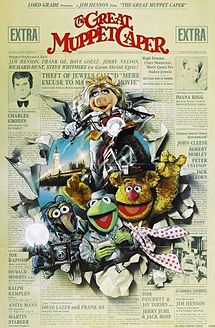
The Story:
Kermit and Fozzie play identical twins who work as newspaper reporters, along with their buddy Gonzo, who serves as their photographer. The trio travel to dreary England where they hope to interview Lady Holliday (Diana Rigg), a fashion designer who has been plagued by a series of robberies targeting her valuable jewel collection. Through some simple farce, Kermit mistakes Lady Holliday’s receptionist, Miss Piggy, for the real Lady Holliday, which impedes his ability to get a good story. His ability to get Miss Piggy is also impeded, by Lady Holliday’s ne’er-do-well brother, Nicky (Charles Grodin), who is in fact the jewel thief. Nicky frames Miss Piggy, which leaves it up to Kermit and the rest of the Muppet gang – who Kermit, Fozzie and Gonzo meet at their hotel – to foil Nicky and clear Piggy’s name.
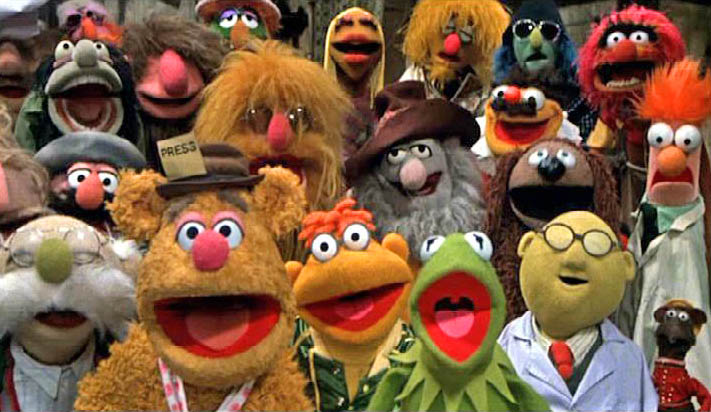
What Works:
Right off the bat The Great Muppet Caper expands beyond the meta-shenanigans of the first Muppet film in an interesting way. After we meet Kermit, Fozzie and Gonzo inexplicably flying around in a hot air balloon while discussing the film’s opening credits – commenting on how “nice” the title is; Fozzie asking what “BSC” stands for in Director of Photography Oswald Morris’s credit (British Society of Cinematographers, FYI); Gonzo marveling at how many people worked on the film, to which Kermit replies “Just wait until you see the end credits.” – the hot air balloon both literally and figuratively lands in the movie. The Kermit, Fozzie, and Gonzo we saw in the opening credits are the “real” Muppets we met in The Muppet Movie, but as Kermit explains to the audience after the balloon lands, they will be playing characters in the film; characters still named Kermit, Fozzie and Gonzo, who have the exact same personalities, but who are no longer entertainers, plus Kermit and Fozzie are now brothers. This tactic is exceedingly weird and unnecessary. Which is also what makes it sort of genius. It further extends an crucial aspect of The Muppet Show that wasn’t present in The Muppet Movie, which is that on the TV show we are seeing the Muppets playing themselves (so to speak), but many of them are actors who then perform in sketches on stage (“Pigs in Space,” “Veterinarians’ Hospital,” etc). So though it is never said out loud, The Great Muppet Caper is presumably a film the Muppets made after signing that “standard rich and famous” contract with Lew Lord at the end of The Muppet Movie. Extrapolating this over the whole franchise, if we so choose, we can technically infer that all the Muppet movies exist in the same reality, regardless if Kermit and the gang are playing themselves.
Considering that the time periods are the same (in a bigger-picture sense), my mind naturally seems to want to draw a parallel between the original Muppet trilogy and the original Star Wars trilogy. And this is definitely the Empire Strikes Back of the Muppet trilogy. More sophisticated, edgier, and thus potentially alienating for the broad family base that had been established with the first film. This is a loose parallel, of course, as Henson and Lucas were playing in two very different playgrounds, but like Empire demonstrated with Lucas, Caper is showing us a Henson flushed with success (Muppet Movie made over $200 million, adjusted for 2011 dollars) and entirely confident to wade a little closer to the deep end of the pool. This was after all the Henson who was only a year away from his most experimental and puppet-envelope pushing film, The Dark Crystal. Caper delivers on all the aspects Muppet fans would want, the music, the schtick comedy, the favorite characters. But Henson clearly wanted to expand his horizons. Aside from Kermit, Fozzie, Gonzo and Piggy, the majority of the other Muppets are treated as a collective blob, which allows Henson to focus on more of a narrative — versus the episodic sketch-like nature of the first film that allowed for the side characters to be showcased more readily.
The other small but still noticeable shift in the film is the British element. Those who know their Henson history know that Henson Studios worked out of the UK, where The Muppet Show was produced, despite using American puppeteers and American guest-hosts. So, though lost on the common audience, there is something fun about Henson loosing the Muppets in their actual home. As a child I absolutely did not get most of the Brit gags in the film, especially the lengthy set-piece in which John Cleese and Joan Sanderson (who doesn’t really count as a celebrity cameo) play the two most upper-crusty Britishy Brits ever. The set-piece is part of the Miss Piggy pretending to be Lady Holliday farce. Piggy made Kermit guess her address, and though Kermit said, “Probably some highbrow street,” Piggy jumped on his response, stating that she lived at “17 Highbrow St.” In good ol’ absurdist Muppet fashion, of course there is a 17 Highbrow St, which Piggy must sneak into. The truly gut-busting comedy of the scene is how impossibly dry and dull Cleese and Sanderson are, as they endlessly discuss the weather while eating and don’t seem the least bit ruffled by spotting “a pig climbing the outside of the house.” To those who haven’t watched Monty Python or other British comedies, this whole sequence is a potential misfire. It’s not that the sequence is confusing, or some inscrutable in-joke, but part of the reason that comedy doesn’t always play well internationally is that cultural gags tend not to have the same impact outside of that culture. But now viewing it as an adult, the Cleese segment is easily the funniest section of the movie for me — I loved that Piggy breaking into the house (full of intense action music) is inter-cut with the most asinine conversation imaginable. Sanderson: “What would you buy if you were bored?” Cleese: “Uh. A jar of calf’s foot jelly.” The movie even has a British look, from using actual locations, down to the drab Earth-tones of the color schemes. The Happiness Hotel, where all the Muppets are staying, seems reminiscent of a BBC comedy from the era.
Kermit, Fozzie and Gonzo make a great trio. Kind of a Kirk, Spock, Bones team of radically differing personalities. And if Fozzie stole the first movie, Gonzo steals Caper. The least necessary member of a trio generally has all the best lines, as they tend to serve as the button gag to conversations the two more important characters are having. And such is the case with Gonzo, who manages to feel like the comic relief in a movie that is already a comedy. His love of getting injured is endlessly hilarious – such as getting his nose painfully caught in some elevator doors, yet once saved telling Fozzie “You gotta stick your nose in here!” Or stopping a cab by diving in front of it, and saying that it is a great trick “when it works.” And though it adds nothing to the larger Muppet mythology, it was nonetheless interesting seeing Gonzo fawn over an actual chicken, and not just the Muppet chickens he usually adores. I also really liked the simple gag seen when the trio are flying to England, riding in crates in the plane’s cargo hold, with their respective crates labeled “Bear. Frog. Whatever.”
The Happiness Hotel, the worst hotel in London, is a great source for running bits. Your options for payment are, “A: Credit card. B: Cash. C: Sneak out in the middle of the night. ” Kermit, Fozzie, and Gonzo say they’ll go with C. For the purposes of the film it was also a smart way to just toss in the remainder of the Muppets, as opposed to the other obvious option, which would be sprinkling them throughout the film in random parts. I do miss seeing more of certain characters, but the film still manages to give all the old favorites at least one choice moment.
I think scaling back the level of celebrity guest spots was a great move, especially now that Henson and co. are telling more of a real story. Now the guest stars can serve actual functions, playing necessary supporting characters instead of existing purely for the sake of a cameo (though there are a couple of those too). The late-great Jack Warden shines like a motherfucker in his one scene as our trio’s angry newspaper editor (who was friends with Kermit and Fozzie’s father; pic at bottom). I loved the simple yet oddly hilarious running gag in Warden’s scene where every time he angrily pounds on his desk, some object is launched up into the air. And then of course there is Charles Grodin. Grodin is one of those actors whose career was cut short by self-imposed reasons. Younger audiences will have little to no reason to know who he is now, but for a brief period spanning the late-70’s to the late-80’s he was one of the funniest comedy character actors we had. Like Gene Wilder or John Astin, he had a style that was wholly his own. Then he got a talk show and got weird and went away. Pity. Cast against type here as a free-wheeling ladies man, Grodin hams it up like a champ, sometimes hamming too much, but crafting are memorably cartoony performance all the same.
Caper has some very memorable Miss Piggy antics, such as her Herculean escape from jail and her epic Busby Berkeley swimming pool musical number, featuring an obviously dubbed singing performance by Charles Grodin — a meta gag Miss Piggy draws attention to later when insulting Nicky, noting that he didn’t even do his own singing. On paper it seems a questionable choice to once again have Kermit meeting, courting and falling for Miss Piggy, but I like the convention this is establishing. It works.
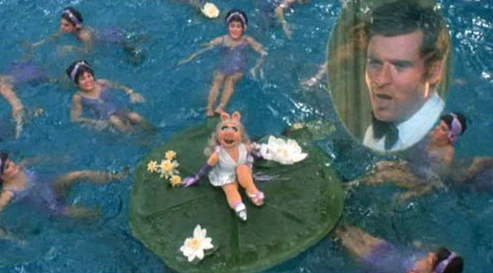
What Doesn’t Work:
I’m sure there is a legit behind-the-scenes reason, but you’d think after nabbing an Oscar nomination and writing one of the most beloved songs of the past three decades, Paul Williams and Kenny Ascher would have been asked back to write songs for Caper. Maybe they said ‘no.” Maybe they didn’t have time. Who knows. Joe Rasposo, who wrote the theme to Sesame Street, plus famous Sesame Street Muppet tunes like “Bein’ Green” and “C is for Cookie,” is a logical replacement. Sadly, Caper‘s music, while fun and mostly good, doesn’t even come close to The Muppet Movie‘s phenomenal soundtrack. And it actually features one song which I find genuinely terrible, the Dr. Teeth and the Electric Mayhem synth mess “Night Life.” Doubly terrible is that this is the only Electric Mayhem song we get in the film.
As with The Muppet Movie, Caper loses some of its steam towards the end, which is possibly just the inevitable case with any film that is so absurd and meta, and thus can’t rely on the kind of emotional investment that something more sincere engenders. Though this is a very minor critique, as the film certainly doesn’t go into a nose-dive or anything.
While I wouldn’t truly classify this is something that “doesn’t work,” I nonetheless reacted very different to some of Animals bits in Caper. Animal chasing women around yelling “Woman! Woman!” was possibly my single favorite Muppet gag as a kid. Now I can’t help finding it a little, how shall we say, “rapey.” Especially once Nicky’s sexy model henchwomen are all knocked unconscious on the floor and Animal climbs on top of them and does one of his classic Animal joyful chuckles.
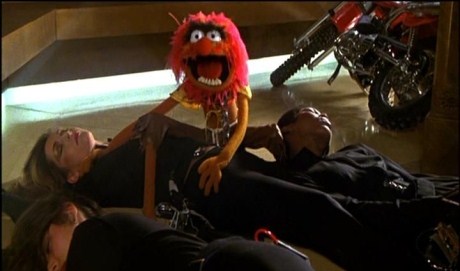
“Raaaaaaaaaaaaaaape!”
Celebrity Cameo Count: 7 (and I’m including Oscar the Grouch)
Best Celebrity Cameo: The double whammy of Peter Ustinov as a Truck Driver who gets car jacked by Miss Piggy and tossed into a pile of trash, and Sesame Streets‘ Oscar the Grouch.
Truck Driver: What are you doing here?
Oscar the Grouch: A very brief cameo.
Truck Driver: Me too.
Best Pun:
Kermit: We’re going to catch those crooks red-handed.
Beauregard: What color are their hands now?
Worst (aka Best) Fozzie Joke: “If that’s the Happiness Hotel, I’d hate to see what the sad one looks like.”
Most Ridiculous/Bizarre Joke: Not the running gag that Kermit and Fozzie are identical twins, but the running gag that they only look identical when Fozzie is wearing his hat; climaxing in this exchange between a father and his daughter who see Kermit sulking on a park bench:
Girl: Look, Dad. There’s a bear.
Father: No, Christine, that’s a frog. Bears wear hats.
Best Meta Moment/Line: After Lady Holiday has just explained her entire backstory to Miss Piggy.
Miss Piggy: Why are you telling me all this?
Lady Holiday: It’s plot exposition. It has to go somewhere.
Joke No Child Could Understand: When Floyd informs Kermit that Animal is upset because he missed the latest exhibition at the National Gallery. Then Animals starts screaming “Renoir!” Hell, I’d imagine plenty of American adults wouldn’t necessarily get that either.
Sadly Under-Featured Muppet: Bunsen and Beaker.
Should There Have Been a Sequel: Yup. Keep ’em coming.
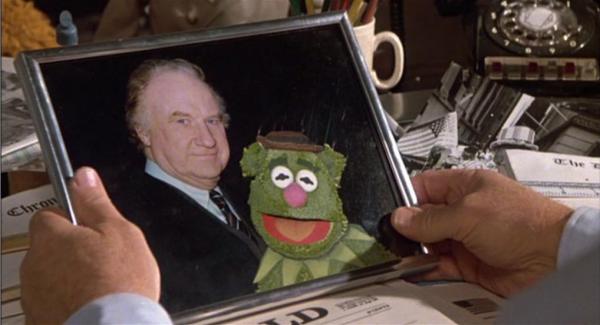
Up Next: Jason The Muppets Take Manhattan
DISCUSS THE FRANCHISE ON THE BOARDS
previous franchises battled
Critters
Death Wish
Hellraiser
Leprechaun
Phantasm
Planet of the Apes
Police Academy
Rambo
Tremors